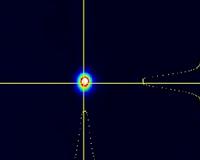 |
Boulder CO (SPX) Mar 11, 2011 Physicists at the National Institute of Standards and Technology (NIST) have demonstrated an electromechanical circuit in which microwaves communicate with a vibrating mechanical component 1,000 times more vigorously than ever achieved before in similar experiments. The microscopic apparatus is a new tool for processing information and potentially could control the motion of a relatively large object at the smallest possible, or quantum, scale. Described in the March 10 issue of Nature, the NIST experiments created strong interactions between microwave light oscillating 7.5 billion times per second and a "micro drum" vibrating at radio frequencies 11 million times per second. Compared to previously reported experiments combining microscopic machines and electromagnetic radiation, the rate of energy exchange in the NIST device-the "coupling" that reflects the strength of the connection-is much stronger, the mechanical vibrations last longer, and the apparatus is much easier to make. Similar in appearance to an Irish percussion instrument called a bodhran, the NIST drum is a round aluminum membrane 100 nanometers thick and 15 micrometers wide, lightweight and flexible enough to vibrate freely yet larger and heavier than the nanowires typically used in similar experiments. "The drum is so much larger than nanowires physically that you can make this coupling strength go through the roof," says first author John Teufel, a NIST research affiliate who designed the drum. "The drum hits a perfect compromise where it's still microscale but you can couple to it strongly." The NIST experiments shifted the microwave energy by 56 megahertz (MHz, or million cycles per second) per nanometer of drum motion, 1,000 times more than the previous state of the art. "We turned up the rate at which these two things talk to each other," Teufel says. The drum is incorporated into a superconducting cavity cooled to 40 milliKelvin, a temperature at which aluminum allows electric current to flow without resistance-a quantum property. Scientists apply microwaves to the cavity. Then, by applying a drive tone set at the difference between the frequencies of the microwave radiation particles (photons) and the drum, researchers dramatically increase the overall coupling strength to make the two systems communicate faster than their energy dissipates. The microwaves can be used to measure and control the drum vibrations, and vice versa. The drum motion will persist for hundreds of microseconds, according to the paper, a relatively long time in the fast-paced quantum world. In engineering terms, the drum acts as a capacitor-a device that holds electric charge. Its capacitance, or ability to hold charge, depends on the position of the drum about 50 nanometers above an aluminum electrode. When the drum vibrates, the capacitance changes and the mechanical motion modulates the properties of the electrical circuit. The same principle is at work with a microphone and FM radio, but here the natural drum motion, mostly at one frequency, is transmitted to the listener in the lab. The experiment is a step towards entanglement-a curious quantum state linking the properties of objects -between the microwave photons and the drum motion, Teufel says. The apparatus has the high coupling strength and low energy losses needed to generate entanglement, he says. Further experiments will address whether the mechanical drumbeats obey the rules of quantum mechanics, which govern the behavior of light and atoms. The drum is a key achievement in NIST's effort to develop components for superconducting quantum computers and quantum simulations, while also working toward the widely sought scientific goal of making the most precise measurements possible of mechanical motion. Quantum computers, if they can be built, could solve certain problems that are intractable today. The microwave and radiofrequency signals in the new electromechanical circuit could be used to represent quantum information. NIST scientists plan to combine the new circuit with superconducting quantum bits to create and manipulate motion of relatively large objects on the smallest (quantum) scales. The experiment reported in Nature is a prelude to cooling the drum to its "ground state," or lowest-energy state. Starting from the ground state, the drum could be manipulated for the applications mentioned above. In addition, such control would enable tests of the boundary between the everyday classical and quantum worlds. The drum also has possible practical applications such as measuring length and force with sensitivities at levels of attometers (billionths of a billionth of a meter) and attonewtons (billionths of a billionth of a newton), respectively. J.D. Teufel, D. Li, M.S. Allman, K. Cicak, A.J. Sirois, J.D. Whittaker, and R.W. Simmonds. 2011. Circuit cavity electromechanics in the strong coupling regime. Nature. March 10.
Share This Article With Planet Earth
Related Links National Institute of Standards and Technology (NIST) Computer Chip Architecture, Technology and Manufacture Nano Technology News From SpaceMart.com
 New MIT Developments In Quantum Computing
New MIT Developments In Quantum ComputingCambridge, MA (SPX) Mar 04, 2011 Quantum computers are computers that exploit the weird properties of matter at extremely small scales. Many experts believe that a full-blown quantum computer could perform calculations that would be hopelessly time consuming on classical computers, but so far, quantum computers have proven hard to build. At the Association for Computing Machinery's 43rd Symposium on Theory of Computing in ... read more |
|
| The content herein, unless otherwise known to be public domain, are Copyright 1995-2010 - SpaceDaily. AFP and UPI Wire Stories are copyright Agence France-Presse and United Press International. ESA Portal Reports are copyright European Space Agency. All NASA sourced material is public domain. Additional copyrights may apply in whole or part to other bona fide parties. Advertising does not imply endorsement,agreement or approval of any opinions, statements or information provided by SpaceDaily on any Web page published or hosted by SpaceDaily. Privacy Statement |